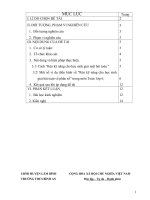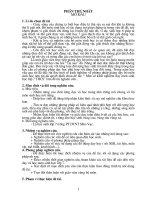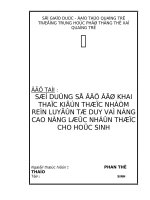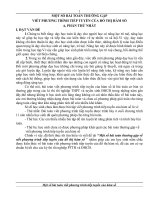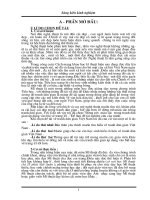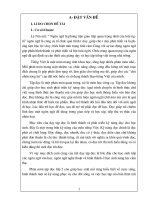SK KINH NGHIEM 2010
Bạn đang xem bản rút gọn của tài liệu. Xem và tải ngay bản đầy đủ của tài liệu tại đây (99.48 KB, 16 trang )
TABLE OF CONTENT
PART 1. INTRODUCTION
I. The problem 2
II. Aims and significance 3
III. Organization of the study 3
PART 2. LITERATURE REVIEW
I. Errors in language learning process 4
I.1. Definition of error and its role in language learning and teaching 4
I.2. Error visus Mistake 4
II. Error Analysis
III. Types of errors 6
III.1. Interlingual errors 6
III.2. Intralingual errors 6
III.2.1. Overgeneralization 6
III.2.2. Ignorance of rule restriction 6
III.2.3. Incomplete application of rules 6
III.2.4. False concepts hypothesized 6
III.3. Developmental errors 7
PART 3. METHODOLOGY
I. The research questions 8
II.Method Review 8
III. Research Design 8
III.1. Subjects 8
III.2. Data Collection Method 8
IV. Techniques of Analysis 9
V. Presentation of Data Results
VI. Discussion 10
VI.1. Strategies accounting for the L1 transfer errors 10
VI.2. Strategies accounting for Overgeneralization errors 11
VI.3. Teaching Procedures in dealing with error patterns 11
VI.3.1. Language input activity 11
VI.3.2. Consciousness- raising 11
CHAPTER 4. CONCLUSION 12
REFERENCES 13
APPENDIXES 14-16
1
CAUSES OF ERRORS IN USING PAST SIMPLE TENSE IN
WRITING NARRATIVES
BY GRADE-10 STUDENTS OF SON LA SPECIALIZED HIGH SCHOOL
PART 1. INTRODUCTION
I. The problem
English has been taught as a specialized subject in Son la Specialized High School
for about 10 years. Despite some considerable success, it is undeniable that teachers and
students here have found many difficulties in their teaching and learning process. The
researcher of this study realized from her observation and experiences for 10 years teaching
in this school that many English specialized students in Son La Specialized High School
have problems with their writing performance. Students are unsuccessful with their writing
products in spite of their teachers’ help and their own attempt. Many students are unwilling
to deal with their writing tasks and even show great anxiety in class. In dealing with
students errors, one teacher may suggest correcting them as soon as they appear, another
one might emphasizes ignoring them, and another one would say to find ways to help
students on the basis of these errors. These suggestions lead to a debate of how to cope with
students’ errors in their wrting tasks to improve their wrting skill. As a result, writing has
become an awkward ostacles for both teachers and students here to overcome.
II. Aims and Significance
There have been many error studies carried out in different languages with different
learners of various language backgrounds. Among the researchers of this kind, Corder
(1967) and Richards (1971) attached the significance of errors in theory and practice of
foreign language teaching and learning. According to Corder (1967), errors as traced their
sources are useful in different ways for the following reasons: First of all, they tell
language teachers how much progress a learner has made towards the target language and
as the result, where s/he needs help and what sort of help s/he needs. Secondly, they
provide evidence for researchers of L2 learning process. It means that the researchers,
through errors, can discover what strategies foreign language learners use in learning and
acquiring a language. Finally, errors can serve practically as good feedback to the learners
for self-adjustment.
2
It is clear that when studied systematically, students’ errors in acquiring L2 can
give significant insights into how the language is learnt.
Apart from the above researchers’ theories, there have been no studies on students’
grammar errors in writing in Son La province. So there are no particular models or
theoretical framework to guide English teachers working there to deal with students’ errors
in writing.
In view of the preceeding discussion, this assignment attempts to:
(a) identify and analyze two main error patterns in using the Past Simple Tense, which
are quite common in written texts by grade-10 students in Son La Specialized High
School, one is considered to be originated in Vietnamese, the other is believed to be
derived from general misuse or overgeneralization of learning strategies.
(b) demonstrate the difficulties the students encounter in learning writing skill.
(c) offer some practical suggestions.
It is hoped that the study can be valuable to both teachers and students as the result
of taking advantages of the research findings and its recomendations for a better strategies
in English learning and teaching process.
For the teachers, the study should help to provide them a deeper theoretical
understanding and a closer look at the students’ writing problems from which they could
seek for proper and more effective teaching methods to treat their students’ errors.
For the students, it is hoped that they will increase their awareness of the causes
which can lead them to errors committing in their writing process to avoid and reduce the
would-be errors. This also should help them feel less challenging and become more
confident in writing activity and be successfull in their written tests as well.
III. Organization of the study
The assignment will first, provide information on the background of the problem
through a literature review; next, identify and analyze the students’ errors; and last, give
some possible recommendations to help reduce errors in students’ compositions.
3
PART 2 LITERATURE REVIEW–
I. ERRORS IN LANGUAGE LEARNING PROCESS
I.1. Definition of error and its role in language teaching and learning
The term “error” is widely used in language learning and teaching. However,
ERROR is differently defined in terms of activities and areas of research by different
scholars and linguists. Afrah (1981, p. 26) states that an error may be an incorrect activity
of information in response to some directive or request for information.
According to Richards (1992, p.126), errors can be considered as the use of
liguistic items in a way that a fluent or native speaker of the language regards as showing
faulty or incomplete learning.
Errors arise from several possible sources, two of which are “ interlingual errors of
interference from the native language, intralingual errors within the target language,
context of learning and communication strategies” ( Brown, 2000, p.218)
Errors play an important role in language learning and teaching. Corder (cited in
Brown, 1994, p. 217) states that “ A learner’s errors . are significant in that they provide…
to the reseracher evidence of how language is learned or acquired, what strategies or
procedures the learner is employing in the discovery of the language”.
I.2. Error versus mistake
When we see something wrong with a piece of written work, we must first try to
decide whether it is an error or a mistake. There are different distinction between errors
and mistakes. Chomsky (1965) distinguishes these two terms as “competence errors” and
“performance errors”, in which competence errors result from incomplete knowledge or
inedequate competence of the target language, while performance errors are caused by
some aspect of verbal performance such as lack of attention, fatigue or carelessness.
According to Corder ( 1967, pp 24-25), there are systematic errors, which are caused by
the formulation of incorrect hypotheses about the target language, and non-systematic
errors, which result from memory lapses, physical states such as tiredness, and
psychological conditions such as emotions. In other words, it is broadly understood that
learners make errors when they try to do something with the language which they are not
yet able to do. For example, they may use the wrong form of the verbs, such as in She work
very hard instead of She works very hard, or they may transfer from their mother tongue,
such as in They came to Ha Noi, where is the capital of Vietnam instead of They came to
Ha Noi, which is the capital of Vietnam. Mistakes, on the other hand, are slips of some
kind. Learners have learnt something but perhaps they have temporarily forgotten it for
4
some reason such as carelessness or tiredness. So mistakes refer to an inconsistent
deviation in using the target language.
It is clear that it is not easy to distinguish these two terms. However, it can be
understood that mistakes are caused by the lack of attention, carelessness or some aspect of
performance. And it is also stated by Corder that mistakes are of no significance in the
process of language learning, while errors are systematic and traced back to inadequate
competence of the target language. Therefore, they are inevitable and important to
language learning and teaching.
II. ERROR ANALYSIS
Error analysis, the study of the errors made by second language learners, is often
carried out in order to:
- identify strategies which learners use in language learning
- try to to identify the causes of learner errors
- obtain information on common difficulties in language learning, as an aid to
teaching or in the preparation of teaching materials
( Richards 1992, p.127)
Error analysis, offered as an alternative to Contrastive analysis, has its value in the
classroom research. Whereas contrastive analysis, which may be least predictive at the
syntactic level and at early stages of learning languages (Brown 1994, p. 214), allows for
prediction of the difficulties involved in acquiring a second language.(Richard 1974,
p.172); error analysis emphasizes “the significance of errors in learners’ inter-language
system” (Brown 1994, p.204) may be carried out directly for pedagogic purposes. (Ellis
1995, p.51)
III.TYPES OF ERRORS
In error analysis, it is necessary to identify and describe the learner’s errors. This
provides the teacher valuable information on the strategies employed by the learner, from
which the teacher can plan an effective correction or remedy.
Richard (1974, p.172-173) divides errors into three major types, which are
interference, intralingual and developmental errors.
III.1. Interlingual Errors
Interlingual errors are defined as the influence of the learner’s mother tongue on
the production of the target language in the areas where the languages are remarkably
different. In other words, interlingual errors refer to the second language errors that reflect
5
native language structure. The differences between the first language and the target
language may affect learners in all areas such as pronunciation, grammar, vocabulary, and
in various ways. George puts that “ one-third of the deviant sentences from second
language learners could be attributed to language transfer” ( George, 1971, cited in
Richards, 1984, p.5). And quite frequently, Vietnamese students write English sentences
by translating directly from Vietnamese to English word by word or just put English word
into Vietnamese syntax, because they think in Vietnamese rather in English, as in “ I am
very thankful my parent for give me such a wonderful holiday , ” or in “In that evening we
went buy gifts for all people .”
Lado (1957, p.1) also notes that “errors are originated in the learner’s disposition to
transfer the forms and meanings, and the contribution of forms and meanings of their
native language and culture to the foreign language and culture”. There are both positive
and negative transfers of a set of habits from L1 to learning habits in L2.
According to Cook (1992, p.589), the L1 is present in the L2 learners’ minds,
whether the teacher wants it to be there or not. The L2 knowledge that is being created in
them is connected in all sorts of ways with their L1 knowledge. As a result, he suggests
that when working with L2 learners, teachers must not treat the L2 in isolation from the L1.
III.2. Intralingual Errors
Intralingual errors are those stemming from the strategies of the target language
itself. They reflect general characteristics of rule learning, such as faulty generalization,
incomplete application of rules and failure to learn conditions under which the rules apply.
( Richards, 1974, p.174)
III.2.1. Overgeneralization
Generalization is believed to be crucially important and pervading strategy in
human learning, and the meaningful learning is in fact generalization, so language learning
is a process of generalization. (Brown, 2000, Richards, 1974)
However, “overgeneralization covers instances where the learner craetes a deviant
structure on the basis of his experience of other structures in target language” (Richards,
1974, p.174). In other words, this kind of errors is caused by the failure to take exceptions
into account because of the learners’ insufficient exposure to the target language and lack
of data from which they can derive more complex rules. Another reason lies in the fact that
after having found a rule which appears to work well, learners are not inclined to go
looking for exceptions which will only complicate matters. In other words,
6
overgeneralization is the use of previous available strategies in new contexts. Therefore,
misleading and inapplicable strategies are probably found in some exceptional cases due to
superficial similarities between the two languages. For example, I goed, She can sings or
We are hope, .…
III.2.2. Ignorance of rule restriction
These errors usually fall into the inappropriate use of prepositions, verbs or other
grammatical items like in ‘ They are going to discuss about the new hotel project.’
III.2.3. Incomplete application of rules
Foreign language learners, like L1 learners undergo developmental stages through
which they process target language rules. This is the reason for their imperfect application
of the rules. There are two factors that lead to this violation, including the use of questions
in classroom as elicitation techniques and the ignorance of obtaining L2 rules provided that
they can achieve efficient communication.
III.2.4. False concepts hypothesized
This is rooted in learners’ faulty understanding of distinctions of target language
items. Poor presentation based on the contrastive approach should account for the
confusion between come and go, the use of was and is as past and present marker
respectively.
III.3. Developmental errors
Developmental errors reflect the strategies used by the learner to acquire the
language by forming false hypotheses about the target language from the limited
experience of and exposure to it in the classroom or textbook.
7
PART 3. METHODOLOGY
I. The research questions
The study is aimed to answer the following questions:
i. What are the most common errors in using the Past Simple Tense made by the
grade-10 students of Son La Specialized High School when writing narratives?
ii. What are the causes of these errors?
iii. What actions should be recommended for preventative and curative measures?
II. Method Review
In this research quantitative research method has been used. The reason for this
choice is that the study is aimed to seek for answers to the mentioned questions. In order to
find out the most common errors in the students’ writing and their causes derived from the
grade-11 students of Son La Specialized High School, this analysis should be based on
statistical number. It is necessary to apply the quantitative research approach, which refers
to counts and measures of things. (Beg, 2001). Quantitative studies emphasize the
measurement and analysis of causal relationships between variables, not process. (Lincohn,
1994)
III. Research Design
III.1. Subjects
Subjects to be chosen are Grade-10 students who study English as their specialized
subject. This class consists of 30 students and they come from different districts of Son La
Province. They have learnt English for at least 5 years as one of their compulsory subjects
at school.
The researcher randomly selected 20 participants from this class, both male and
female, to ensure the reliability of the research.
III. 2. Data collection
For the selection of a corpus of language, following the guidelines offered by Ellis
(1995, p.51-52), a sample of written work was collected from 20 students. The students
were asked to write about their most impressive holiday, one of the topics that they have
learnt in their textbook with the length of 150 - 200 words in 45 minutes’ time and were
allowed to consult a dictionary if required.
IV. Techniques of Analysis
8
The techniques employed in the analysis process include identification, labelization,
transferation to indexes and classification.
After the ministration of the instruments, the data were collected from them and
analyzed to the purpose of the study to elicit answers from the research questions proposed.
Data collection consisted of results from 20 essays in practice. Types of errors were
selected for analysis based on their relative seriousness and frequency of occurrence. The
resulting data were investigated in detail, resulting in a number of several different
categories, as predicted (Brown, 1994- p.214). The errors were then explained and
thoroughly examined to find the sources of errors due to L1 and L2 transfer, paying
particular attention to negative transfer.
V. Data presentation and analysis
The errors caused by the L1 were identified as resulting from negative transfer and
non-existent linguistic items. (Brown, 1994, p.194), by comparing the students’ sentence to
an equivalent one translated into the L1. The effects of negative transfer were seen in the
omission of the past maker ed– , as in:
After a hard day they gathered and chat in an informal atmosphere.
Staying there, I feel very happy and comfortable.
The first impression with me is the warm welcome of the family.
These sentences represent a past context through the time orientation (italics).
However, the present forms of the verbs (underlined) are employed to convey the past
context, a very common tendency in this error pattern. (20 errors)
Other sentences such as
She knows everythings about Ha Long Bay.
The caves have many rock crystals which are small pieces of a substance with many
even sides.
I liked the people there. They are very friendly and funny.
….
are superficially correct at the sentence level, however, if the context, that is pastness, is
taken into account, they are incorrect. ( see other examples in Appendix 2, p.14)
Errors based on the overgeneralization of learning strategies were categorized in the
following types:
In type 1, the students used present perfect or past perfect for past simple as in
9
It was the first time I have gone to sea.
There was a church which had been built long ago.
Type 2 involved using Ing form for past simple tense, for example,
They greeted me with all their heart, taking my hands, asking me everything about
my life and study.
We went to the fields to look at the sea and fishing, walking in the small paths in
the village.
Type 3 involved the misuse of the negative past form of had as in
Although the village hadn’t a cinema or theatre, I still prefer village life to the life
in a big city.
Last weekend I hadn’t go to school so my friend invited me to his house …
In the evening, I hadn’t anything to do so I was listened to people talking.
Type 4 consisted of using the passive form for the active form, as in
I and my mother arrived in Ha Tay when the sunset was let down.
In the evening, I hadn’t anything to do so I was listened to people talking.
( Appendix 3)
VI. Discussion
In the light of existing theories, the results and examples from the performance
data, this section primarily focus on the strategies the students employ that accounted for
their errors and how the designed teaching procedures can help the students deal with these
errors.
VI.1. Strategies accounting for the L1 transfer errors
The students had considerable difficulties in conveying the past tense form, which
is in agreement with what was pointed by “ as . .” The main cause is likely to be… …
associated with the negative transfer of Vietnamese language in the form of a translation
strategies in producing sentences in English. The strategy was so widely employed that the
students dropped the regular past tense ed– morpheme in situations where the context
demands past tense. Most students had less difficulty in constructing a first clause or
sentence with correct past tense form. However, when a student tried to use a conjunction,
it resulted in an error. The strategy behind it would be that the student first formed a
sentence using the ismple past tense, then added a conjunction and while writing the next
10
sentence unconsciously ignored the pastness. The students’ most frequent errors in this
study are evident in the use of the coordinator: and and but; sub-coordinator : because,
when, which. Although attributing the source to language transfer, also commented on the
difficulties the students could have in the usage of English conjunctions.
VI.2. Strategies accounting for the Overgeneralization errors
From the 4 main types of overgeneralization errors (section V), it is clear that the
students overgenerated some different rules. In the first type, the students misused the
usage of the present perfect tense and the past perfect tense as an action which completely
happened before another.
In type 2, the students produced the first sentence/ clause in the correct form of the
past simple tense, but had problems with the second one due to the wrong application of
Ing Participles. This also shows the students’ weakness in writing complex sentences.
Errors of type 3, in which the students had confusion in using the negative past
form of have as hadn t’ . That is originated in the overgeneralization of the negative present
form ( haven t’ and hasn t’ ).
Type 4 represents one of the most common errors among the students in Son La
Specialized High School, in which many students tend to add be before other verbs and
this results in errors.
VI.3. Teaching procedures in dealing with error patterns
Ellis ( 1997-a, pp.119-123), emphasizing the significance of input, states that the
acquisition may be facilitated by teaching explicit knowledge through CR tasks assisted by
the operations of noticing and comparing, which are considered necessary for acquisition to
take place, and that the input can become implicit knowledge when the operation if
intergrating is added.
VI.3.1. Language input activity
Transfer errors and overgeneralization errors discussed above can be great part
attributable to the lack of exposure to the English language. In fact, when it comes to the
writing practice of the Vietnamese EFL students, they have only one hour class every two
weeks. Besides, they are short of the input of authentic materials. The language they
contact is specially adopted and simplified in syntax. That is why it is necessary for the
teacher to enlarge the exposure of authentic language. Non- classroom input data should be
supplied to increase the chances for students to contact English after class. After listening
11
or reading, students may be asked to do some different tasks on writing. And wide reading
is a straightforward matter of getting input.
VI.3.2. Consciousness-raising (C-R)
Consciousness-raising means that “successful learning of whatever kind comes
about only when what is to be leraned can be meaningfully related to something that is
already known” (Rutherford, 1987, p.16). It is better to conduct the C-R activity in the
intensive reading class, since the EFL teachers in Vietnam often focus on the explanation
of the text while students spend a lot of time rote learning.
There is one example of C-R activity:
After reading a text, students are asked to identify all the words referring to the
present and simple past tense. They will be encouraged to make a useful comparison with
that of the L1 and find out similarities and differences between patterns in the L1 and
patterns in the L2. By being aware of the differences, teachers tend to help students to
bridge the knowledge gap between the first and second language and ultimately to reduce
the negative effect on the second language from the first language.
PART 4 - CONCLUSION
It can be concluded from the study that the students have a lot of difficulties in
using the past simple tense in writing narratives. The biggest problem is the omission of
-ed morpheme as a marker of regular verb form of the past simple tense, which is due to the
direct translation from Vietnamese. Besides, the students also overgenerated the rules of
the past simple tense and the usage of the present perfect tense as well as the past perfect
tense which led to the misuse errors.
The study also points out errors are mainly in complex sentences. This reflects the
students’ weakness in combining sentences or using conjunctions.
These errors patterns can be dealt with by enlarging the exposure of authentic
language and consciousness-raising during teaching procedures.
In sum, what I have done is extremely limited, and I hope it can offer some
implication for the English teaching and learning in Son La Specialized High School in
some way. In fact, this is only starting point for my further research on second language
acquisition and development.
12
REFERENCES
Berg, B.L. 2001. Qualitative Research Method for Social Science. Boston: Allyn and
Bacon.
Brown, H. 1994. Principles of language learning and Teaching. Englewood Cliffs:
Prentince Hall Regents.
Cook, V. 1981. Error Analysis and Interpretation. Oxford: Oxford University Press.
Corder, S. 1967. The Significance of Learners Errors. Error Analysis’ . London: Longman.
Corder,S. 1974. “ Idiosyncratic Dialects and Errors Analysis”. In Richards, J. (Ed.).
Error Analysis: Perspectives on Second Language Acquisition. 158-171. Essex: Longman
Ellis, R. 1995. Understanding Second Language Acquisition. Oxford: Oxford University
Press.
Ellis, R. 1997 (a) SLA Research and Language teaching. Oxford: Oxford University Press.
Ellis, R. 1997 (b) Second Language Acquisition . Oxford: Oxford University Press.
Lado, R. 1957. Language Across Culture. University of Michigan Press.
Richard, J. 1974. “ A Non-Contrastive Approach to error Analysis”. In Richards, J. (Ed.).
Error Analysis: Perspectives on Second Language Acquisition. 158-171. Essex: Longman
Richards, J. 1984. Error Analysis. England: Longman.
Richards, J. et al. 1992. Dictionary of Language Teaching and Applied Linguistics.
Longman
Rutherford, W. Second Language Grammar: learning and Teaching.England: Longman.
Selinker, L. 1974. “Interlanguage”. In Richards, J. (Ed.). Error Analysis: Perspectives on
Second Language Acquisition. 158-171. Essex: Longman
13
APPENDIX 1 A SAMPLE OF A STUDENT S WRITTEN WORK– ’
Topic: Your most impressive holiday
Last summer, I had travelled with my mother and her collegues. we had a good
time. I have never forgotten this time which is a happy time for me. We went from Son La
town to Ho Chi Minh City. It’s a long and interesting journey. This distance approximates
the length of the country.
The first, we stopped by Thanh Hoa Town. Then we visited Nghe An where Ho Chi
Minh was born. There are many souvenirs of President Ho Chi Minh. The second, we
stayed at Hue City where is famous for beautiful sights. Hue used to be old capital. So it
has many museums of kings. In spite of summer, but it is cool and rain. People there are
friendly and studious. Ho Chi Minh City is the third. Oh, I feel very surprised. I can’t
imagine that it can big as it is. Ho Chi Minh City is a crowded and busy city. People there
are active and comfortable.
I learnt very much from this journey. I knew history in life. I knew character in
three regions of our country. Although it has many different but we still are a people.
appendix 2 ERRORS ORIGINATED IN NEGATIVE TRANSFER–
Using Present Form for Past Form
1. Because of Tet holiday, my parents allow me to stay there for two weeks.
2. The first time I come there when I was five years old.
3. During the holiday, I often went to the seaside in the afternoon and I meet many new
friends there.
4. The scenery was beautiful and I enjoy walking on the sand and seeing wavelet.
5. We stayed in a hotel which look over the bay.
6. There was 7 floors in it but but there isn’t any lift so we had to walk up and down the
stairs.
7. We stayed in a room which isn’t very expensive.
8. My mother went on for a walk and drink Coca Cola on the beach.
9. We went from Son La to HCM City, which is a very long journey.
10. In spite of summer, but it is cool and rainy.
11. Then my grandmother and I go to the market together. The market is near the village.
14
12. After a hard day, everybody gathered in a simple family meal and chat in an informal
atmostphere.
13. I loved the village b/c it is very quiet and the life is slow and easy.
14. Staying there, I feel very happy and comfortable.
15. Last weekend I hadn’t go to school so my friend invited me to his house, which is 30
kms from the town.
16. Although the village hadn’t a cinema or theatre, I still like it.
17. When the school year finish, I was offered a holiday by my parents.
18. I made friends with many people. They are very young but do farming work very well.
19. Not only is there many beautiful flowers but also the scenery is very attractive.
20. On Monday morning we go to Da lat.
appendix 3 COMMON ERRORS FROM–
OVERGENERALIZATION
1.Type 1. Using present perfect or past perfect for past simple
1. In that time I have met many interesting people.
2. The holiday has impressed me very much.
3. It was the first time I have gone to sea.
4. There was a church which had been built long ago.
5. I had been promising with myself to try to learn English by many ways.
6. Last summer I had travelled with my mother and her collegues.
2. Type 2. Using Ing form for past simple
1. They greeted me with all their heart, taking my hands, asking me everything about my
life and study.
2. We went to the fields to look at the sea and fishing, walking in the small paths in the
village.
3. Type 3. Using hadn t ’ instead of didn t have’
1.Although the village hadn’t a cinema or theatre, I still prefer village life to the life in a
big city.
2. Last weekend I hadn’t go to school so my friend invited me to his house …
3. In the evening, I hadn’t anything to do so I was listened to people talking.
4. I hadn’t enough English capital to talk to the foreigners.
15
4. Type 4. Using the passive form for active form
1. I and my mother arrived in Ha Tay when the sunset was let down.
2. In the evening, I hadn’t anything to do so I was listened to people talking.
3. We were first stopped at Son La Hotel, where we decided to take a rest.
16
